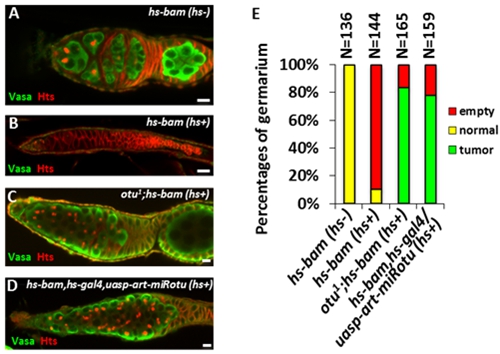In adult tissues, stem cells are defined by their unique capacity to self-renew and produce non-equivalent daughters that can differentiate into cell lineages to maintain tissue homeostasis. Misregulation of stem cell functions has been implicated in a variety of human diseases such as degenerative diseases and cancer. Thus, understanding the regulatory mechanisms of adult stem cells is important for stem cell biology and their future use in regenerative medicine.
The Drosophila ovarian germline stem cell (GSC) system has provided a heuristic model to study stem cell regulation in vivo. Early genetic studies have demonstrated that the bag of marbles (bam) gene plays a critical role in promoting GSC and cystoblast (CB) differentiation in Drosophila ovary. During the last decades, genetic functions of bam and its regulation in early germ cells have been extensively investigated, however, the biochemical nature of the Bam protein has remained a mystery.
Prof. Dahua Chen and Prof. Qinmiao Sun, who lead a research team at Institute of Zoology, Chinese Academy of Sciences characterize that Bam functions as an ubiquitin-associated protein to regulate germline stem cell function and germline cyst division. Their mechanistic study reveals that Bam forms a complex with Otu, a deubiquitinase, to promote deubiquitination and stabilization of CycA, thereby promoting germline stem cell differentiation.
This research not only identifies a novel biochemical function of Bam, which contributes to GSC fate determination, but also uncovers a novel mechanism by which a coordinated action via both ubiquitination and deubiquitination pathways is critical to balance stem cell self-renewal and differentiation.
This study entitled “Bam-dependent deubiquitinase complex can disrupt germ-line stem cell maintenance by targeting cyclin A” was published online in the PNAS in May 8th. It was supported by the National Basic Research Program of China, Natural Science Foundation of China, and Strategic Priority Research Program of the Chinese Academy of Sciences.
http://www.pnas.org/content/early/2017/05/05/1619188114.full

Figure Otu genetically interacts with bam. (Image by Dahua Chen's group)
Contact:
Chen Dahua
Institute of Zoology, Chinese Academy of Sciences (http://english.ioz.cas.cn/)
Chaoyang District, Beijing 100101, P.R.China
Email: chendh@ioz.ac.cn

